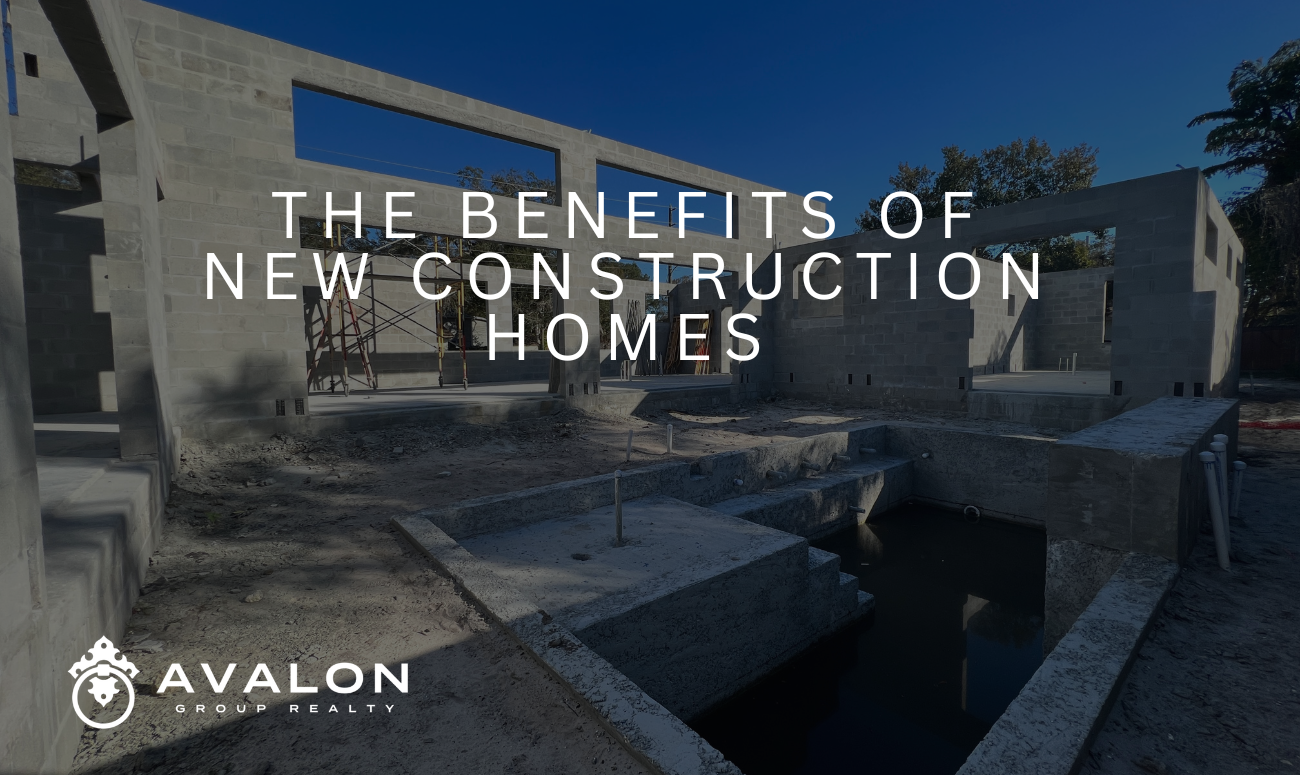The Benefits of New Construction Homes: The Housing Crisis: A Realtor’s Perspective on New Construction
As a seasoned realtor with Avalon Group Realty in St. Petersburg, FL, I’ve witnessed firsthand the challenges faced by homebuyers in today’s market. The United States is grappling with a severe housing shortage, desperately needing 3.2 million homes and counting. This crisis has far-reaching implications for both buyers and the real estate industry as a whole.
The Benefits of New Construction Homes: The Aging Housing Stock Dilemma
Over the past two decades, the average age of U.S. housing stock has increased from 31 to 40 years. This stark statistic underscores a critical issue: we’re simply not building enough new homes to meet demand. Consequently, average prices have skyrocketed, making homeownership increasingly unattainable for many Americans.
Aaron Hunt, Broker of Avalon Group Realty, shares his insights: “Last year, we saw the average U.S. household able to afford just 16% of all homes listed. This affordability crisis is pushing more and more potential buyers out of the market, creating a cycle that’s difficult to break.”
The New Construction Solution
While building new homes is the most apparent solution, misconceptions about new construction often deter prospective buyers. Many harbor doubts about quality, character, price, and the overall process. However, these assumptions are largely unfounded.
Pam Amante, a fellow realtor at Avalon Group Realty, emphasizes the benefits of new construction: “New homes offer modern amenities, energy efficiency, and customization options that older homes simply can’t match. Plus, buyers can avoid the hidden costs and surprises often associated with purchasing older properties.”
The Hidden Costs of Older Homes
Although older homes may seem like a bargain at first glance, costing on average 16% less than new properties of the same size, this initial savings can be deceiving. Renovations to bring these properties up to modern standards can be astronomical, with the average home renovation costing $41,600. In some cases, these costs can easily reach six figures.
Josh Zanow, another realtor with our team, cautions: “Buyers often underestimate the true cost of purchasing an older home. Between inspections, appraisals, and unexpected repairs, the financial burden can quickly outweigh any initial savings.”
Maintenance and Upkeep Considerations
Even after renovations, owners of older properties face ongoing maintenance and upkeep costs, which can amount to approximately 4% of the property’s value each year. This recurring expense is often overlooked by first-time buyers but can significantly impact long-term affordability.
The Benefits of New Construction Homes: The Case for New Construction
Given these challenges, the case for new construction becomes increasingly compelling. Developers are in a prime position to capitalize on the growing demand for new homes, addressing several key issues in the process.
-
Addressing Housing Shortages
New construction allows developers to maximize space efficiency, particularly in crowded urban areas. By building upwards or creating smaller units, developers can transform single plots into multiple homes, better serving the needs of today’s market.
-
Energy Efficiency Benefits
Modern construction methods and materials result in homes that are 30% more energy-efficient than those built just a decade ago. This efficiency not only benefits the environment but also translates to long-term savings for homeowners.
Yvette Kim, our eco-conscious realtor, notes: “Buyers are increasingly prioritizing energy efficiency. New construction homes offer a level of sustainability that’s difficult and costly to achieve in older properties.”
-
Profitability and Buyer Preferences
From a business perspective, new construction often makes more financial sense for developers. Buyers are willing to pay a premium for new homes, appreciating the warranties, customization options, and peace of mind that come with a brand-new property.
The Road Ahead
While the U.S. real estate market is ramping up efforts to meet demand, with an estimated 1.3 million units set to be built annually by 2025, this still falls short of addressing the current shortage. The demand is undoubtedly there – what we need now are more builders and a shift in mindset towards embracing new construction.
As realtors, we play a crucial role in educating buyers about the benefits of new construction and helping them navigate the process. By dispelling myths and highlighting the long-term advantages, we can contribute to addressing the housing crisis while serving our clients’ best interests.
In conclusion, while old homes certainly have their charm, the U.S. needs to open its arms to new construction to overcome the current housing crisis. As Aaron Hunt succinctly puts it, “New construction isn’t just about building houses; it’s about building communities and securing the future of American homeownership.”
As we move forward, it’s clear that new construction will play a pivotal role in shaping the real estate landscape. By embracing this change, we can work towards a more sustainable, affordable, and accessible housing market for all Americans.
The Benefits of New Construction Homes: The Future of Real Estate: Embracing New Construction
As we look towards the future of real estate, it’s clear that new construction will play a pivotal role in addressing the housing crisis and shaping the market. Let’s explore some key areas where new construction is making a significant impact.
Smart Homes and Technology Integration
One of the most exciting aspects of new construction is the ability to seamlessly integrate cutting-edge technology from the ground up. Smart home features are becoming increasingly popular and can be more easily incorporated into new builds.
Aaron Hunt comments, “We’re seeing a growing demand for homes with built-in smart technology. From energy management systems to advanced security features, buyers are looking for homes that offer convenience and efficiency.”
Some key smart home features in new construction include:
- Integrated home automation systems
- Energy-efficient appliances and HVAC systems
- Built-in charging stations for electric vehicles
- Advanced security and surveillance systems
Pam Amante adds, “These tech-forward features not only appeal to younger buyers but also add significant value to the property in the long run.”
Sustainable Building Practices
Sustainability is no longer just a buzzword; it’s becoming a necessity in modern construction. New builds are incorporating eco-friendly materials and practices that benefit both the environment and homeowners.
Josh Zanow notes, “Green building practices are not just good for the planet; they’re also attractive to buyers who are increasingly environmentally conscious and looking to reduce their carbon footprint.”
Some sustainable building practices in new construction include:
- Use of recycled and locally sourced materials
- Installation of solar panels and other renewable energy sources
- Water-saving fixtures and rainwater harvesting systems
- Green roofs and sustainable landscaping
Flexible and Multi-Functional Spaces
The COVID-19 pandemic has significantly changed how we use our living spaces. New construction is adapting to these shifts by incorporating more flexible and multi-functional areas.
Yvette Kim observes, “Post-pandemic, we’re seeing a surge in demand for homes with dedicated home offices, fitness spaces, and areas that can easily transform to serve multiple purposes.”
Features of flexible living spaces in new construction:
- Movable walls and partitions
- Built-in workspace nooks
- Convertible rooms (e.g., guest room to home gym)
- Indoor-outdoor living spaces
Community-Centric Developments
New construction isn’t just about individual homes; it’s about creating thriving communities. Developers are increasingly focusing on building neighborhoods that foster connection and provide amenities that enhance quality of life.
Aaron Hunt explains, “Today’s buyers are looking for more than just a house; they want a lifestyle. New developments that offer community spaces, recreational facilities, and a sense of belonging are in high demand.”
Elements of community-centric developments:
- Shared green spaces and parks
- Community centers and gathering areas
- Walking and biking trails
- Local shops and services within the development
Addressing Affordable Housing Needs
While new construction is often associated with luxury homes, there’s a growing focus on using new building techniques to address affordable housing needs.
Pam Amante shares, “Innovative construction methods like modular and prefab homes are making it possible to build quality, affordable housing more quickly and cost-effectively.”
Strategies for affordable new construction:
- Modular and prefabricated construction
- Micro-homes and efficient use of space
- Mixed-income developments
- Public-private partnerships for affordable housing projects
The Benefits of New Construction Homes: Embracing Change in the Real Estate Market
As we navigate the complexities of the current housing crisis, it’s clear that new construction offers numerous solutions and opportunities. From addressing housing shortages to meeting the evolving needs of modern homebuyers, new builds are shaping the future of real estate.
Josh Zanow concludes, “As realtors, it’s our responsibility to educate buyers about the benefits of new construction and help them see beyond the initial price tag to the long-term value these homes offer.”
By embracing new construction and the innovations it brings, we can work towards a more sustainable, efficient, and accessible housing market. The future of real estate is being built today, one new home at a time.
Bridging the Gap: From Crisis to Opportunity
As we transition from discussing the current housing crisis to exploring the future of real estate, it’s crucial to understand how new construction serves as a bridge between these two realities. This pivotal connection illuminates the path forward for both industry professionals and homebuyers alike.
The Shift in Perspective
While the housing shortage presents significant challenges, it also offers a unique opportunity for growth and innovation in the real estate sector. Aaron Hunt of Avalon Group Realty emphasizes this point: “What we’re experiencing isn’t just a crisis—it’s a catalyst for change. New construction is our chance to reimagine housing for the 21st century.”
This shift in perspective is essential. Rather than viewing the shortage solely as a problem, we can see it as an invitation to create solutions that not only address current needs but also anticipate future demands.
From Scarcity to Abundance
The transition from a scarcity mindset to one of abundance is key in this process. Yvette Kim notes, “By focusing on new construction, we’re not just adding inventory—we’re creating opportunities for buyers to find homes that truly meet their needs, both now and in the future.”
This approach allows us to move beyond simply filling the housing gap and instead focus on building communities that enhance quality of life for residents.
Adapting to Changing Needs
The link between our current situation and the future of real estate lies in adaptability. As Pam Amante points out, “New construction gives us the flexibility to respond to changing market demands quickly. Whether it’s incorporating home offices for remote work or creating more energy-efficient spaces, we can evolve with our buyers’ needs.”
This adaptability is crucial in ensuring that the homes we build today will remain relevant and valuable for years to come.
The Benefits of New Construction Homes: Collaborative Solutions
Addressing the housing crisis through new construction requires collaboration between various stakeholders. Josh Zanow emphasizes this point: “It’s not just about developers building more homes. It’s about realtors, city planners, policymakers, and community members working together to create sustainable housing solutions.”
This collaborative approach bridges the gap between identifying the problem and implementing effective solutions, paving the way for the innovative developments discussed in the following section.
By understanding this crucial link between our current challenges and future opportunities, we can approach new construction with optimism and purpose. As we move forward, it’s clear that embracing new construction is not just about solving a crisis—it’s about building a better future for homeowners and communities across the nation.
If you are looking to build a home or find a new construction to buy, contact the best St Pete Realtor by visiting https://avalongrouptampabay.com/




